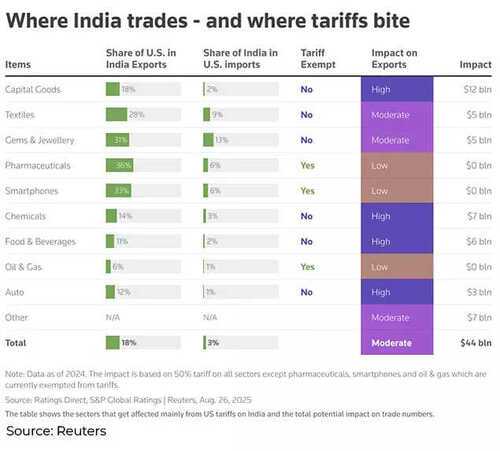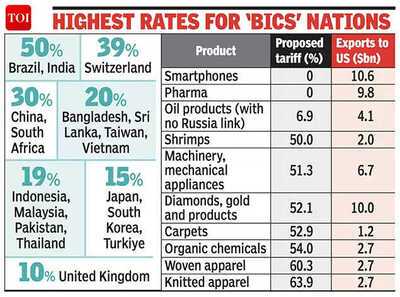When Prime Minister Narendra Modi lands in Tianjin this week for the Shanghai Cooperation Organisation (SCO) summit-his first visit to China since 2018-it won’t just be a symbolic handshake with Chinese President Xi Jinping . It will be a signal: India is hedging. Against the West. Against US President Donald Trump. And possibly against the very strategic alignment that Washington spent two decades building.
Modi’s presence at the SCO, alongside Russian President Vladimir Putin and a host of Global South leaders, may seem like another multilateral engagement. But in the context of a 50% US tariff hike on Indian exports-imposed largely to punish India’s oil purchases from Russia-it begins to look like something more coordinated: a budding counterweight to US pressure, coalescing in real time.
“This summit is about optics, really powerful optics,” said Eric Olander, editor-in-chief of the China-Global South Project, in remarks to Reuters. “Just look at how much BRICS has rattled Donald Trump, which is precisely what these groups are designed to do.”
The optics include Modi and Xi sharing a stage despite years of tense, even bloody, border standoffs. And while the meeting may be “more optics than substance,” as Reuters’ Laurie Chen noted, the timing is what matters. Trump’s aggressive tariff policy has pushed India to do something previously unthinkable: entertain a détente with Beijing while tightening its already warm ties with Moscow.

Why it matters: The strategic cost to the US could be enormous

A strategic miscalculation in the making
The Trump administration's decision to punish India over Russian oil imports-while sparing China from equivalent sanctions-has created what many in New Delhi view as a double standard.
According to Reuters columnist Clyde Russell, “Trump’s tariffs on India risk having the opposite effect of what he intended, with the side consequence of driving a country that had been something of an ally into the arms of US opponents.”
And the trade punishment comes despite India doubling its energy imports from the US this year, and despite a long-touted US-India strategic convergence.
The damage is already showing:
What India wants
India’s pivot isn’t about abandoning the US. It’s about strategic autonomy. Modi’s government is walking a geopolitical tightrope-leveraging relationships with multiple poles of power while avoiding dependency on any single one.
"To me, it’s not a reset in the sense that India is saying ‘we are done with America.’ That’s not going to happen,” said Manoj Kewalramani of the Takshashila Institution to CNN. “The United States remains [India’s] most important partner in the world, but China is our largest neighbor. We have to live with it.”
That logic is now being backed by action: restarting flights with China, reopening pilgrimage routes in Tibet, resuming tourist visas, and even discussing climate and technology cooperation.
Modi himself emphasized this recalibration after a recent meeting with China’s foreign minister Wang Yi: “Stable, predictable, constructive ties between India and China will contribute significantly to regional as well as global peace and prosperity,” the PM said.

Zoom in: What’s happening behind the scenes
Analysts expect incremental but real outcomes from the Modi-Xi meeting, including:
Modi’s presence at the SCO, alongside Russian President Vladimir Putin and a host of Global South leaders, may seem like another multilateral engagement. But in the context of a 50% US tariff hike on Indian exports-imposed largely to punish India’s oil purchases from Russia-it begins to look like something more coordinated: a budding counterweight to US pressure, coalescing in real time.
“This summit is about optics, really powerful optics,” said Eric Olander, editor-in-chief of the China-Global South Project, in remarks to Reuters. “Just look at how much BRICS has rattled Donald Trump, which is precisely what these groups are designed to do.”
The optics include Modi and Xi sharing a stage despite years of tense, even bloody, border standoffs. And while the meeting may be “more optics than substance,” as Reuters’ Laurie Chen noted, the timing is what matters. Trump’s aggressive tariff policy has pushed India to do something previously unthinkable: entertain a détente with Beijing while tightening its already warm ties with Moscow.
Why it matters: The strategic cost to the US could be enormous
- The damage isn’t limited to trade only. India has long been viewed in Washington as a linchpin in countering China’s rise, and a key member of the Quad alliance-alongside the US, Australia, and Japan. But Trump’s escalating tariffs and rhetoric have rattled New Delhi, and pushed Modi closer to Beijing and Moscow in a balancing act of necessity.
- Politico reported that “India’s 50% tariff rate will be nearly as high as the 55% levy Chinese goods face,” suggesting that Washington now treats New Delhi as it does Beijing.
- However, India’s new alignment may be more pragmatic than ideological, but its consequences are very real:
- It challenges years of bipartisan US effort to cultivate India as a counterweight to China.
- It boosts China's global standing, especially in the Global South.
- It hands Vladimir Putin a diplomatic win, giving him leverage despite Western sanctions.
- And it signals to other developing countries that there’s room to maneuver outside the US-led order.
- “Losing India would be the worst outcome for the United States,” analysts have warned, a CNN report said.
- “This detente was definitely started by Trump,” Yun Sun of the Stimson Center told CNN.
- The SCO summit comes amid an extraordinary geopolitical realignment, one that Trump himself may have accelerated through economic coercion rather than cooperation.
- India’s move toward Russia and China isn’t just symbolic. It includes:
- Restarting direct flights with China for the first time since the 2020 border clash.
- Exploring joint ventures with Chinese firms in critical tech sectors.
- Keeping Russian oil flowing despite US pressure, citing economic necessity.
- Potential revival of the Russia-India-China (RIC) trilateral format, dormant for nearly a decade.
- “The only real winner here is Vladimir Putin,” wrote Reuters columnist Clyde Russell. “He keeps selling oil to India while watching the US-India relationship crumble.”
- Putin will stay in China even after the SCO summit ends, attending a World War II military parade in Beijing-a symbolic gesture of enduring partnership. The Russian Embassy in Delhi also confirmed that trilateral talks between China, India, and Russia are on the horizon.
- As Bloomberg reported, “China will seek to demonstrate Global South solidarity at SCO,” and that unity increasingly includes a shared resistance to Western economic coercion.
A strategic miscalculation in the making
The Trump administration's decision to punish India over Russian oil imports-while sparing China from equivalent sanctions-has created what many in New Delhi view as a double standard.
According to Reuters columnist Clyde Russell, “Trump’s tariffs on India risk having the opposite effect of what he intended, with the side consequence of driving a country that had been something of an ally into the arms of US opponents.”
And the trade punishment comes despite India doubling its energy imports from the US this year, and despite a long-touted US-India strategic convergence.
The damage is already showing:
- Cancelled orders from Indian exporters.
- Market instability.
- A potential slowdown in India’s export-led growth.
- “Clearly a low moment,” Mark Linscott, a former USTR negotiator who worked on India policy during Trump’s first term, told Politico.
What India wants
India’s pivot isn’t about abandoning the US. It’s about strategic autonomy. Modi’s government is walking a geopolitical tightrope-leveraging relationships with multiple poles of power while avoiding dependency on any single one.
"To me, it’s not a reset in the sense that India is saying ‘we are done with America.’ That’s not going to happen,” said Manoj Kewalramani of the Takshashila Institution to CNN. “The United States remains [India’s] most important partner in the world, but China is our largest neighbor. We have to live with it.”
That logic is now being backed by action: restarting flights with China, reopening pilgrimage routes in Tibet, resuming tourist visas, and even discussing climate and technology cooperation.
Modi himself emphasized this recalibration after a recent meeting with China’s foreign minister Wang Yi: “Stable, predictable, constructive ties between India and China will contribute significantly to regional as well as global peace and prosperity,” the PM said.
Zoom in: What’s happening behind the scenes
Analysts expect incremental but real outcomes from the Modi-Xi meeting, including:
- Troop withdrawal agreements along the Himalayan border.
- Reduced visa and trade barriers.
- Climate and technology cooperation.
- Potential use of non-dollar payment systems in trade with Russia and China.
- Even if the summit is more about symbolism than substance, it carries weight. “It’s about optics-really powerful optics,” said Olander. “A public display of unity that challenges the US-centric world order.”
- The SCO’s expansion and growing convening power show that non-Western blocs are gaining ground.
- India is reconsidering the value of being Washington’s “preferred partner” if that comes with strings-and tariffs.
- And China, India, and Russia may increasingly coordinate on reforming the global order, particularly in trade and finance.
- “India was never going to be the bulwark against China that the West thought it was,” wrote Foreign Policy. “Modi’s China visit marks a potential turning point-toward a more coordinated position between both countries.”
- The Xi-Modi handshake may not lead to a formal alliance. But it does show that under Trump’s pressure, India, China, and Russia have found something rare in geopolitics: common cause.
- “This is not a bromance,” said Farwa Aamer of the Asia Society Policy Institute. “It’s realpolitik.”
You may also like

IAEA back in Iran: First since US strikes on nuclear facilities; only limited access cooperation still uncertain

Man Utd suffer humiliating Carabao Cup exit to League Two Grimsby as Ruben Amorim hits new low

Man Utd player ratings vs Grimsby: One 0/10 and four 1/10s in shock Carabao Cup defeat

Corrie's Sally Dynevor takes on huge challenge – 16 years after cancer diagnosis

London's iconic red phonebox on sale for £10k - and could be the cheapest in the capital







